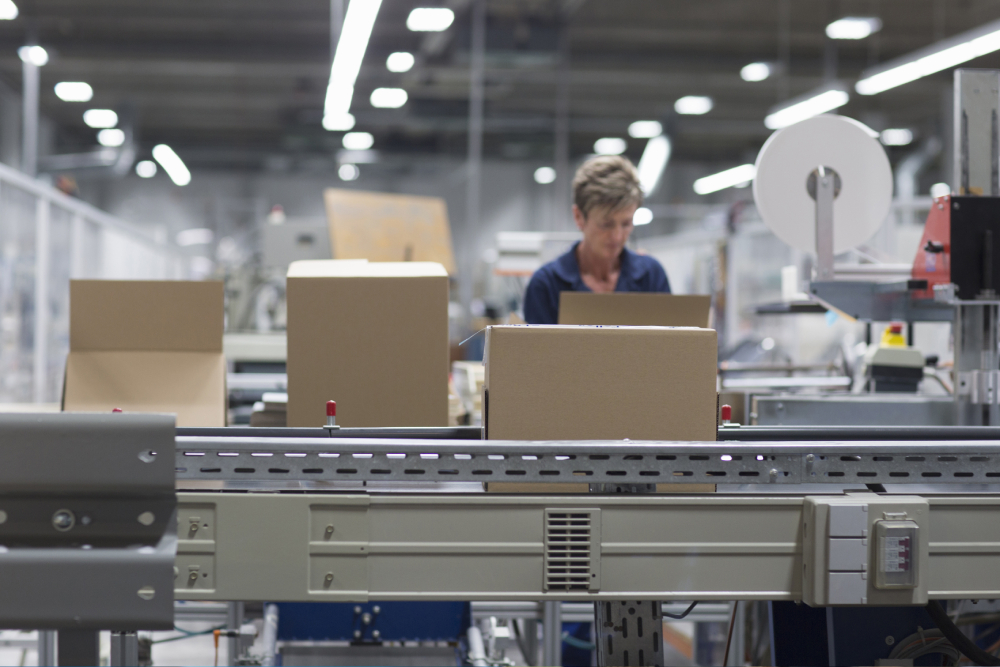

At first, all a warehouse conveyor system can do is move items from point A to point B. But that’s just the tip of the iceberg. Integrating a warehouse conveyor system into your process can significantly improve your operations, workplace safety, labor costs, and more.
Let’s break it down in this blog!
1. Better Workflow
We’ll start with the most obvious benefit of integrating conveyor systems in your warehouse: enhanced efficiency and workflow. They streamline the entire operation end to end. Instead of manually moving items, products glide effortlessly along predetermined paths. Thus minimizing delay. Items can move faster between different stages, like receiving, storing, retrieving, and shipping zones.
Specific Details:
- Systems use sensors and barcodes to direct products accurately. For example, a package might be routed through different speed zones based on its destination.
- Conveyor systems run continuously, which is especially useful during peak seasons.
- Detailed planning can ensure that the conveyor layout matches the flow of goods in your warehouse. This alignment reduces unnecessary stops and starts, maximising overall throughput.
2. Reduced Workplace-Related Injuries
Safety is a critical concern when manual labour is involved. Conveyor systems significantly lower the risk of injuries associated with heavy lifting and manual handling. Your workers can focus on monitoring and maintenance while the warehouse conveyor system handles repetitive, strenuous tasks.
Specific Details:
- Fewer workers will be needed to lift loads.
- Less physical strain leads to fewer musculoskeletal injuries.
- Conveyors can be engineered to include cushioned areas and emergency stops wherever human interaction is expected.
3. Reduction in Labor Costs
Despite the significant upfront costs of installing a warehouse conveyor system, its returns in the long run are significant. For instance,
- Staff are freed up from routine tasks. As a result, you may require fewer staff.
- Reduced need for overtime during busy seasons
- Scaling operations is easier with additional conveyor modules than hiring additional labor.
4. Optimal Space Utilization
One of the lesser-discussed advantages of integrating a warehouse conveyor system is the utilization of space. Well-designed systems significantly free up space in your warehouses. This creates more space for inventory and storage.
Furthermore, conveyor systems come in modular units, meaning they can be rearranged or expanded easily based on demand or business needs. Finally, some systems may also use multi-level platforms, increasing storage capacity without expanding the building’s footprint.
5. Data-Driven Insights and Integration With Other Technology
Modern conveyor systems are built to seamlessly integrate with warehouse management software to provide real-time data and analytics. This integration creates a dynamic environment where decisions are based on insights.
For instance,
- Sensors can detect product movement. The data collected can be fed into the management system to enable better control and route optimization.
- Advanced systems can monitor the health of each component. This means you can schedule maintenance before a complete breakdown occurs.
- Key performance indicators (KPIs) related to throughput, energy usage, and efficiency can be monitored. Managers can adjust processes on the fly based on this data.
This shift towards data-led systems means that you can anticipate and identify bottlenecks as well as solve the concerns before they affect productivity.
Conclusion
Integrating a warehouse conveyor system is a systematic and strategic approach that touches every facet of warehouse operations. It helps you stay agile in a competitive market and deliver products faster and safer while optimizing every inch of space and labor resource.
Automag India is a leader in conveyor systems, backed with 35+ years of experience. We manufacture the best-in-class material handling systems, portable conveyor belts, and special purpose equipment for various industries like automobile, auto component, logistics, tyre production, battery assembly, and any industry that needs unit load handling equipment.
Contact us today, and let’s discuss how we can adopt conveyor systems for your warehouse operations.
ALSO READ
Understanding Conveyor Systems and Their Operations
A Guide on Best Conveyor Systems for Automobile Manufacturing


